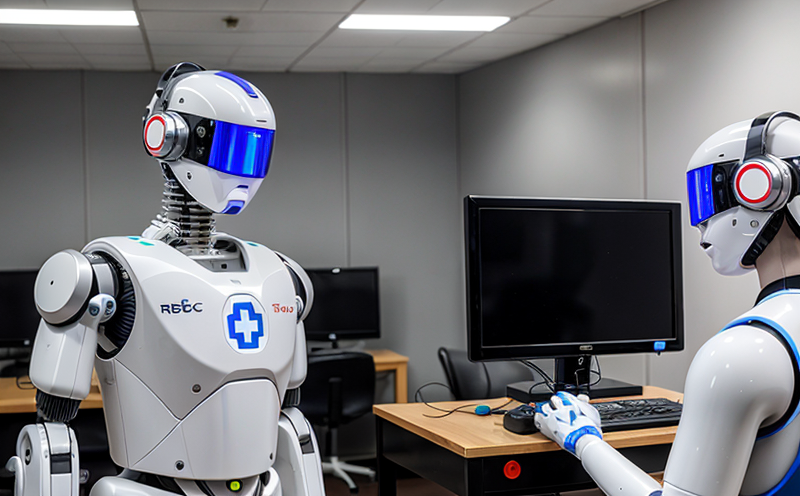ISO 22166 Modularity and Interoperability of Service Robotics Systems
The ISO 22166 standard is a cornerstone in the testing and certification of modular and interoperable service robotics systems. This standard ensures that robotic systems, whether they are autonomous or semi-autonomous, can seamlessly integrate into various environments without compromising safety, efficiency, or performance. Compliance with this standard is particularly important for manufacturers aiming to produce adaptable robots capable of working in diverse industries such as healthcare, logistics, manufacturing, and public services.
Service robotics have become increasingly sophisticated, offering solutions that enhance productivity and reduce human effort across multiple sectors. However, the modularity and interoperability aspects are critical for ensuring these systems can adapt to changing environments and requirements without requiring complete redesign or replacement. The ISO 22166 standard addresses this need by providing a framework for testing robotic systems based on their modularity and ability to operate in conjunction with other robotic units.
Modularity refers to the ability of service robots to be configured into different forms, including adding or removing components as needed. Interoperability ensures that these robots can communicate effectively with each other and with existing systems within a facility or organization. This is especially important for large-scale deployments where multiple robots perform coordinated tasks.
The testing process outlined in ISO 22166 involves several key steps to evaluate the modularity and interoperability of service robotics systems:
- Component Testing: Each component of the robotic system undergoes individual evaluation to ensure it meets the necessary performance criteria for modularity and interoperability.
- Integration Testing: The components are then integrated into a complete system, where their ability to function together is tested. This includes evaluating how well they can exchange data and commands.
- Performance Testing: The final step involves assessing the overall performance of the robotic system under various conditions to ensure it meets all specified requirements for modularity and interoperability.
These tests are conducted using a variety of real-world scenarios that simulate actual usage environments. This helps identify any potential issues early in the development process, allowing manufacturers to make necessary adjustments before product release. The comprehensive nature of these tests ensures that service robotics systems not only meet current standards but also anticipate future technological advancements.
The implementation of ISO 22166 is essential for ensuring that robotic systems can be easily maintained and upgraded over their lifetimes. By adhering to this standard, manufacturers demonstrate their commitment to producing robust, flexible solutions designed to meet evolving market demands. This not only enhances customer satisfaction but also fosters innovation within the industry.
In summary, ISO 22166 plays a vital role in promoting the development and deployment of modular and interoperable service robotics systems. Its rigorous testing protocols help guarantee that these systems operate reliably across different applications while maintaining high levels of safety and efficiency.
Applied Standards
The ISO 22166 standard is widely recognized in the field of robotics, particularly for its emphasis on modularity and interoperability. This standard has been adopted by numerous organizations around the world to ensure that service robotic systems meet stringent quality control measures.
- ISO/IEC 80004:2019: General Principles Concerning Standardization and Conformity Assessment in Respect of Artificial Intelligence Systems. While not directly related, this standard provides a broader framework for understanding the principles behind standardization efforts in AI systems.
- ISO/TS 22167:2018: Test methods to evaluate modularity and interoperability of service robots. This technical specification offers detailed guidance on how to perform tests according to ISO 22166, making it an essential companion document for laboratories performing these assessments.
- ASTM E3457-18: Guide for Testing the Modularity and Interoperability of Service Robots. This guide complements ISO 22166 by providing additional insights into the practical aspects of conducting such tests, including specimen preparation and instrumentation requirements.
These standards work together to provide a comprehensive approach to testing service robotics systems, ensuring that they are both modular and interoperable according to industry best practices. Compliance with these standards helps manufacturers achieve higher levels of reliability and performance in their robotic products.
Why Choose This Test
Selecting ISO 22166 testing for your service robotics systems offers several compelling benefits, particularly for organizations focused on innovation and quality assurance. By choosing this test, you ensure that your robots meet the highest industry standards, thereby enhancing their marketability and competitiveness.
Firstly, compliance with ISO 22166 demonstrates a commitment to excellence in design and engineering. This can significantly boost brand reputation among consumers and stakeholders alike. Secondly, it enables easier integration into existing infrastructure, reducing installation costs and downtime for end-users. Thirdly, the modularity aspect encourages continuous improvement, allowing manufacturers to add new features or functionalities without disrupting operations.
Furthermore, this testing ensures that robotic systems remain safe and effective even when faced with unforeseen challenges such as environmental changes or technological disruptions. This resilience is crucial in sectors like healthcare where reliability cannot be compromised under any circumstances.
Achieving ISO 22166 certification also opens up new opportunities for international collaboration and expansion into global markets. Many countries have adopted these standards, making them a prerequisite for entry into certain regions or industries. Lastly, participating in rigorous testing processes like those defined by this standard fosters a culture of excellence within your company, driving continuous improvement across all aspects of product development.
By investing time and resources into ISO 22166 compliance, you invest in the future success of your organization. It’s an investment that pays dividends through increased customer satisfaction, reduced risk, enhanced reputation, expanded market reach, and sustained competitive advantage.





